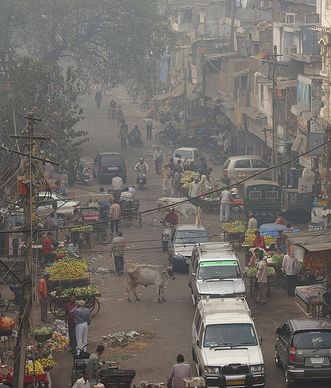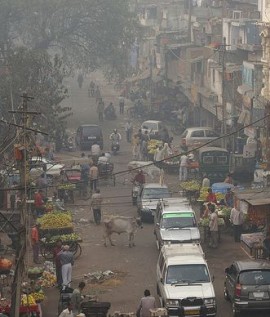Improving Urban Air Quality
Delhi, India
| Location | Delhi, India |
|---|---|
| Pollutant | Sulfur Dioxide, particulates, carbon monoxide and other components of urban air pollution. |
| Cause | Emissions from automobiles, power plants, as well as other local industrial and urban sources. |
| Health Impact | Long-term exposure to relatively low levels of pollutants can cause serious health problems, including cancer, respiratory and cardiovascular diseases, and asthma. The health effects of outdoor air pollution fall disproportionately on infants, children, and the elderly. |
| Output | India’s Ministry of Environment and Forests undertook extensive measures to reduce vehicle emissions in the late 1990s including the introduction of a fleet of buses powered by compressed natural gas, mandatory inspection and maintenance requirements, emission norms, more stringent clean fuel requirements, and a pollution tax [1]. More recently, a subway system was constructed and the highway network was rehauled to reduce congestion. |
| Outcome | From 1993 to 2000, ambient carbon monoxide (CO) decreased by almost half1 and lead concentrations fell by 75 percent. Between 2000 and 2003, as buses were converted to CNG, sulfur dioxide levels (SO2) decreased by 34.8 percent, and particulate matter (PM10) levels, by 7 percent [2]. |
| Implications | Use of alternative fuel vehicles can yield significant urban air quality improvements, however, early gains have been neutralized due to the increase in the number of personal vehicles and increased commuting distances. The completion of an extensive subway system should help to reduce this burden. |
Context
In the last half-century, increasing migration and industrialization have caused a boom in the number and density of mega-cities worldwide. While in 1950 just 54 million people lived in cities with populations larger than 5 million, this number is expected to be more than ten times higher by 2015 [3]. Despite tremendous social and technological advances, this rapid growth has come with a heavy price: the confluence of overcrowding with the rise of personal automobile ownership has made air pollution common in these ever-larger urban centers.
Urban areas in topographic basins or valleys where surrounding hills or mountains inhibit air circulation are also prone to the build-up of persistent and high levels of photochemical smog. The health impacts caused by outdoor air pollution have been widely recognized by both national governments and multilateral development organizations as a threat to urban populations, especially in developing countries. People living in large urban areas, especially in developing countries, where the health risks of air pollution may be underestimated and pollution controls lacking, are routinely exposed to concentrations of airborne pollutants that have been shown to cause negative health effects in both the short and long term. Cited as one of the Top Ten Worst Pollution Problems in Blacksmith Institute’s 2008 report, urban air pollution persists as a growing environmental health issue [4].
Site Details
India carries a large part of this heavy burden. In the National Capital Territory (NCT) of Delhi, urban population increased by 51.53 percent between 1991 and 2001 [5], and is expected to reach 21 million inhabitants by 2015, making Delhi the 5th largest city in the world [6]. In addition to the ecological and industrial problems this poses, Delhi’s communities and government have had to face a dramatic increase in pollutants resulting from the surge in personalized vehicles. Historically the city has relied largely on small, 2 and 3-wheeled vehicles equipped with 2-stroke engines, which emitted more than 70 percent of hydrocarbons and 50 percent of carbon monoxide in Delhi’s air. Overloaded, poorly maintained buses and diesel trucks are also traditional fixtures on the city streets. This combination led to a dramatic rise in pollution from total suspended particles (TSP), which reached a high of 450 μg/m³ in 1996 [7].
Exposure Pathways
People are exposed to outdoor air pollution by breathing in pollutants, and by exposing eyes and skin while they are outdoors. Exposure is intensified by vigorous activity, as pollutants are drawn more deeply into the lungs during periods of physical exertion. People who live or work in close proximity to emission sources such as power plants, local industry or highways/major roadways are often exposed to higher concentrations of pollutants for longer periods of time, which elevates their risk of developing acute and/or chronic health problems. Long-term exposure to relatively low levels of pollutants can also cause serious health problems. Cities in developing countries often suffer heavily from outdoor air pollution, due to the heavy use of diesel fuel for transport vehicles, the predominance of coal for power generation, the proximity of urban populations to industrial facilities, and the lack of advanced emission controls for vehicles and industry.
Health Impact
Major health effects associated with outdoor air pollution are typically chronic pulmonary and cardiovascular stress from the fine particles and include increased mortality, respiratory and cardiovascular disease, lung cancer, asthma exacerbation, acute and chronic bronchitis, restrictions in activity and lost days of work.The health effects of outdoor air pollution fall disproportionately on infants, children and the elderly. People with pre-existing health conditions are also significantly affected. Studies indicate that chronic exposure to nitrogen dioxide (NO2) may impair lung development in children and cause structural changes in the lungs of adults. Exposure to ground-level ozone also causes burning and irritation of the eyes, nose and throat, and the drying out of mucous membranes, reducing the ability of the body to resist respiratory infections. Overall, health effects depend on many factors: the pollutant and its concentration in the air, the presence of multiple pollutants, temperature and humidity conditions, and the exposure period of a person to the pollutant, in both the short- and long-term. It is estimated that 7,500 Indians die every year from outdoor air pollution in Delhi alone. A significant reduction in vehicular pollution is key to saving those lives, as well as reducing soaring health care costs. To accomplish these goals, studies have established a target of reducing particulate matter (PM10) by 142 μg/m³ [8].
Intervention
Since the early 1990s, India’s Ministry of Environment & Forests (MoEF) has undertaken a multi-pronged approach to solving Delhi’s air pollution problem. Officials recognized early on that vehicles contributed almost two thirds of total pollution figures and initially focused their efforts on converting Delhi’s public transportation fleet to cleaner fuels; the first Compressed Natural Gas (CNG) bus was launched on an experimental basis in 1998. Negotiations between the local and national governments and private contractors culminated in 2001 with the progressive conversion of city buses. Delhi now boasts the largest fleet of CNG-powered buses in the world, and has invested in a suitable network of CNG stations to cater for the demand. While buses account for less than 1% of vehicles on the road, they serve almost half of Delhi’s travel needs [9].
CNG’s success in Delhi relied on legal requirements forcing the local government, private operators and individuals to convert to cleaner fuels. Early on, India’s Supreme Court and MoEF introduced emission norms, mandatory inspection and maintenance requirements, and gradually phased out older private vehicles. Through sales tax exemptions and other incentives, the Delhi government helped replace 47,000 older auto-rickshaws and conducted pollution testing on 2.4 million vehicles between 2002 and 2003 alone. Other fuel control measures were introduced: a ban on leaded gasoline, the introduction of EURO I and EURO II emission norms, controls on adulteration of fuel, control of their sulfur content, lowering of benzene content in petrol [10]. These measures eventually led to the wide-scale conversion to natural gas and in 2005 the Supreme Court began imposing a pollution tax on diesel buses that had not yet converted to CNG. The revenues generated allowed the city to invest in other pollution control measures throughout Delhi’s agglomeration.
Following MoEF’s recommendation, Delhi’s government initiated an ambitious project to update its transportation infrastructure. The Delhi Metro Network, started in 1998, opened its doors to commuters in 2002 and has since been a model of speed and efficiency. With further expansion phases planned for the upcoming years, the network will reach 500 km of metro lines by the year 2020. The highway network has also been rehauled, notably with the construction of the brand new, 136 km-long Kundli-Manesar-Palwal (KMP) expressway. This ring road has been an important factor in helping decongestion within Delhi itself.
Results
The partnership’s initiatives, and the government’s stringent legal requirements in regard to the major outdoor air pollution contributors yielded good results. After peaking in 1996, vehicular pollution was curbed and levels of the major pollutants began decreasing: between 1998 and 2003, ambient carbon monoxide (CO) decreased by almost half [11]; from 1993 to 2000, lead concentrations fell by 75 percent; between 2000 and 2003, as buses were converted to CNG, sulfur dioxide levels (SO2) decreased by 34.8 percent, and particulate matter (PM10) levels, by 7 percent [12]. During the same period, however, monitors also observed a 13.7-percent increase in nitrogen dioxide (NO2). This is explained by the dramatic rise in personal vehicles, but also by CNG’s high burning temperatures, which help nitrogen from air react with the oxygen in the combustion chamber, thus resulting in higher NO2 levels than traditional engines. These results are widely considered to show a significant success, even leading one expert to exclaim, “What took 30 years to accomplish, we have done in 5 years.” [13] In 2003, Delhi received the Clean Cities International Award by the U.S. Department of Energy for its aggressive efforts in curbing pollution.
Implementing Organizations
India’s Ministry of Environment & Forests (MoEF), the Supreme Court of India, the Delhi Metro Rail Corporation.
Remaining Challenges
Delhi’s development as one of Asia’s main industrial and financial hubs has caused an important increase in population, leading to an explosion in the number of personal vehicles: from less than a million in 1990 to almost 3 million in 2005 [14]. This rise will present a formidable challenge to Delhi stakeholders, as vehicular pollution contributes 67 percent of the total pollution in the city. [15] In addition, and despite a promising curb in overall vehicular pollution, the Central Pollution Control Board still considers most major pollutants to be above acceptable levels. The high levels of NO2 emitted by CNG, as well as the many other pollutants caused by factors other than vehicles must also be addressed: studies showed that particulate matter (PM10) levels began increasing again in 2003 [16]; this increase is related to small industries, domestic coal burning, thermal power plants and natural sources as well as vehicular pollution, but the trend demonstrates the challenges ahead for Delhi’s population. Government agencies and individuals will need to continue re-assessing fast-changing demographics, technologies and industry in order to prevent a return to the catastrophic pollution levels of 1990’s.
Outcomes of Delhi Air Quality Improvement Measures
| Measures | 1996 | 1998 | 2000 | Outcomes |
|---|---|---|---|---|
| Emissions Norms of Vehicles |
Emission norms made stringent as compared to 1991 | Emission norms for catalytic converter fitted vehicle made stringent. Hot start replaced by Cold start test which gives less emissions | Euro-I equivalent norms for all types of vehicles except passenger vehicles which are EURO-II equivalent | GNG/LPG norms finalized |
| Fuel Quality Improvement | Fuel Quality Specification notified under EPA for the first time. Lead content (g/l) = 0.15 Diesel Sulpher = 0.5% Gasoline Benzene = 5.0% | • Diesel sulpher reduced to 0.25%.
• Gasoline Lead phased out. |
• Diesel sulpher reduced to 0.05% • Gasoline benzene reduced to 1.0% * Gasoline sulphur with 0.05% maximum sulpher in all outlet. • Low smoke 2-T oil introduced |
Diesel with 0.05% sulpher throughout retail outlets NCT. |
| Other Measures | Govt. vehicle to run CNG/Catalytic Converter | • 15 years old commercial vehicle banned.
• Pre-mix 2T oil in retail outlets |
• Buses more than 8 years phased out. • Replacement of pre-1990 autos/taxis with vehicle on clean fuels. • Conversion of post 1990 autos to CNG initiated. • Fuel testing laboratory established. |
All taxis/autos and buses to run on CNG. |
Source: Auto Fuel Policy, 2002, cited in: United Nations Population Division, World Urbanization Prospects: The 2001 Revision
References
Blacksmith Institute. (2008) Top 10 Worst Pollution Problems. New York, NY.
Chelani, A. B., & Devotta, S. (2007) Air Quality Assessment in Delhi: Before and After CNG as Fuel. Environmental Monitoring and Assessment, 125, 257-263.
Narain, U., & Krupnick, A. (2007) The Impact of Delhi’s CNG Program on Air Quality. Resources for the Future Discussion Paper 07-06. Retrieved 10/05/09 from:
→ http://ideas.repec.org/s/rff/dpaper.html
Ravindra, K. et al. (2006) Assessment of Air Quality in Delhi After the Implementation of Compressed Natural Gas (CNG) as Fuel in Public Transport in Delhi, India. Environmental Monitoring and Assessment, 115, 405-417.
United Nations Environment Program. CNG conversion: Learning from New Delhi. Retrieved 10/05/09 from:
→ http://ekh.unep.org/?q=node/1737
United Nations Population Division, World Urbanization Prospects: The 2001 Revision.
Additional Photos
 |
Efforts to improve air quality in Delhi face an uphill battle given a rapidly growing population and expanding metropolitan area. |
Footnotes
[1] Ravindra, K. et al. (2006) Assessment of Air Quality in Delhi After the Implementation of Compressed Natural Gas (CNG) as Fuel in Public Transport in Delhi, India. Environmental Monitoring and Assessment, 115, 405-417.
[2] Chelani, A. B., & Devotta, S. (2007). Air Quality Assessment in Delhi: Before and After CNG as Fuel. Environmental Monitoring and Assessment, 125, 257-263.
[3] United Nations Population Division, World Urbanization Prospects: The 2001 Revision.
[4] Blacksmith Institute. Top 10 Worst Pollution Problems, 2008.
[5] United Nations Environment Program. CNG conversion: Learning from New Delhi. Retrieved 10/05/09 from:
→ http://ekh.unep.org/?q=node/1737
[6] United Nations Population Division, World Urbanization Prospects: The 2001 Revision.
[7] Chelani, A. B., & Devotta, S.
[8] Ravindra, K. et al.
[9] Chelani, A. B., & Devotta, S.
[10] Ibid.
[11] Ravindra, K. et al.
[12] Chelani, A. B., & Devotta, S.
[13] United Nations Environment Program.
[14] Narain, U., & Krupnick, A. (2007) The Impact of Delhi’s CNG Program on Air Quality. Resources for the Future Discussion Paper 07-06. Retrieved 10/05/09 from:→ http://ideas.repec.org/s/rff/dpaper.html
[15] Chelani, A. B., & Devotta, S.
[16] Ravindra, K. et al.

-
Phasing Out Leaded Gasoline
-
Ending Chemical Weapons
-
Improving Indoor Air - Ghana
-
Preventing Mining Pollution - Chile
-
Lowering Radioactivity - Chernobyl
-
Cleaning Urban Air - India
-
Removing Lead - Dom. Republic
-
Recapturing Mercury - Indonesia
-
Reducing Lead - Russia
-
Removing DDT - Tanzania
-
Restoring a Waterway - China
-
Removing Arsenic - India



